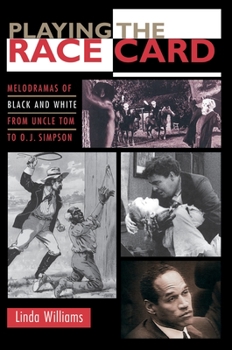Playing the Race Card: Melodramas of Black and White from Uncle Tom to O. J. Simpson
Select Format
Select Condition 
Book Overview
The black man suffering at the hands of whites, the white woman sexually threatened by the black man. Both images have long been burned into the American conscience through popular entertainment, and today they exert a powerful and disturbing influence on Americans' understanding of race. So argues Linda Williams in this boldly inquisitive book, where she probes the bitterly divisive racial sentiments aroused by such recent events as O. J. Simpson's criminal trial. Williams, the author of Hard Core , explores how these images took root, beginning with melodramatic theater, where suffering characters acquire virtue through victimization. The racial sympathies and hostilities that surfaced during the trial of the police in the beating of Rodney King and in the O. J. Simpson murder trial are grounded in the melodramatic forms of Uncle Tom's Cabin and The Birth of a Nation . Williams finds that Stowe's beaten black man and Griffith's endangered white woman appear repeatedly throughout popular entertainment, promoting interracial understanding at one moment, interracial hate at another. The black and white racial melodrama has galvanized emotions and fueled the importance of new media forms, such as serious, "integrated" musicals of stage and film, including The Jazz Singer and Show Boat . It also helped create a major event out of the movie Gone With the Wind , while enabling television to assume new moral purpose with the broadcast of Roots . Williams demonstrates how such developments converged to make the televised race trial a form of national entertainment. When prosecutor Christopher Darden accused Simpson's defense team of "playing the race card," which ultimately trumped his own team's gender card, he feared that the jury's sympathy for a targeted black man would be at the expense of the abused white wife. The jury's verdict, Williams concludes, was determined not so much by facts as by the cultural forces of racial melodrama long in the making. Revealing melodrama to be a key element in American culture, Williams argues that the race images it has promoted are deeply ingrained in our minds and that there can be no honest discussion about race until Americans recognize this predicament.
Format:Hardcover
Language:English
ISBN:0691058008
ISBN13:9780691058009
Release Date:May 2001
Publisher:Princeton University Press
Length:408 Pages
Weight:1.77 lbs.
Dimensions:1.3" x 6.0" x 9.3"
Customer Reviews
1 rating
Written on the Body
Published by Thriftbooks.com User , 23 years ago
This is Film Studies of the first order. Williams takes the idea of melodrama as a mode and intersects it with issues of race and its representation. According to her, in conjuction with the popularity or in the legitimization of a particular medium in American society, the representations of the black male and female bodies take on center stage and gain new significations. The book starts out with Stowe's "Uncle Tom's Cabin" and shows how it stays and strays away from the conventions of the Victorian novel. It then focuses on the Stowe's characterization of the black bodies and how they elicited the sympathy of the readers. Next, it shows how Dixon, with his novel "The Clansmen,' either changes or reverses Stowe's characterizations and themes to elicit another kind of response. However, it is D.W. Griffith's adaptation of the novel, "Birth of the Nation" that had a powerful influence in the society's imagination. Not only did the film legitimize the medium as an art form, it also gave the public a new way of understanding race relations in America. The book covers both the novel and the movie adaptation of "Gone With the Wind" and other cultural texts and ends with the televised trial of O.J. Simpson while keeping on the other eye issues of representation. Linda Williams' project is both multi-disciplinary and multi-media and she weaves them together in a rich study of melodrama as a cultural mode and the ever evolving nature of race relations and representations in our society. She wittily uses Henry James' imagery of the 'leaping fish' to show how melodrama dynamically moves from one medium to the next. Each time it makes an appearance in a big way, it also entails a recasting of black and white or racial representations. Williams achievement lies in her ability to pull together a variety of texts and approaches to engage upon the central issue of race. And she does this in clear, well-written prose. Although this is more like a work of cultural criticism, the book also opens up the possibilities of film studies as a powerful lens or a way of approaching cinema-related queries and dealing with socio-historical matters.





